Categories: Featured Articles » Sources of light
Number of views: 9668
Comments on the article: 2
How to distinguish a bad LED from a good LED
The modern market is filled with a variety of LED lighting products. On sale there are both lamps under the familiar e27 threaded socket and lamps of other types. A separate class of products can be called LED lamps, in which it is impossible to replace the lamp, they do not have a cartridge, and the LEDs are simply soldered on the boards or strips. This begs the question: how to choose a good LED lamp?

What should be the light?
Light requirements may be determined by the design decision, but this is not such a weighty argument as SNiP 23-05-95 and other regulatory documents. Here are two main requirements for lighting rooms:
1. Illumination.
2. The ripple coefficient.
Both requirements depend on what the room is intended for, what and how long they will do something in it. This also implies the so-called class of visual work - it depends on the dimensions of the parts, the contrast with the background of the work surface.
Additionally, one can distinguish such a requirement as color rendering index.
But for the average person, this is all quite difficult at first glance. Let's get it right.
With light, I think it's not complicated. In simple words, this is the amount of light per square meter of the illuminated room or work surface.
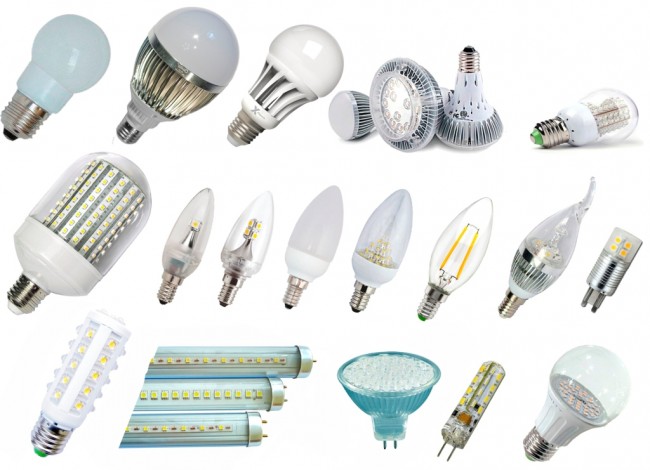
Ripple factor
But the ripple factor is already a more complicated concept. Light pulsations even in 50% can be invisible to the human eye due to individual physiological characteristics of a person and a certain inertia of vision, in other words, you perceive a smoother image than it really is.
Why are ripples dangerous? If you don’t see something, it doesn’t mean that your brain doesn’t see it. The fact is that if a person is and works in a room illuminated by lamps with a high pulsation coefficient for a long time - his fatigue increases, his head begins to hurt, he becomes distracted.
Depending on the type of room, SNiP normalizes pulsations from 10% to 20%, and in some cases it is not standardized (corridors, etc.).
Color rendering index
The color rendering index is equally important. This is a value that determines how natural the colors look under a particular light source. This is especially important if you draw, embroider, paint something in this room or do other visual work, in which the color difference of objects occupies a significant place. A poor color rendering index for luminaires also leads to rapid fatigue and excessive eye strain.
The color rendering index is indicated by the letters CRi or Ra. It is measured by comparing 8 or 14 colors with standards, of course, that special equipment is used for this.

But this is not the only system for determining the index, there are others, for example:
1. CQS in 15 colors

2. TM-30-15 in 99 colors.

The luminaire should have a normal ripple coefficient and color rendering index.
Illumination is measured using a light meter; in most modern models, the ripple factor is also measured.
LED lamps: which ones to choose for a particular room
But back to our lamps. The above was not just a reference to the topic of lighting as such. The fact is that the quality of the lamp is determined primarily by its light qualities, and already in the second by reliability. Lamp brightness is also not an indicator of quality.
Everything used to be simpler, incandescent bulbs were used everywhere, and they had everything in order, with color rendition and ripples, but progress does not stand still ...
The ripple factor of the LEDs depends on the quality of the power source from which they operate.But a high-quality power source, in particular a current source, requires good circuitry, and this in turn is a cost. We will consider this in more detail below.
The color rendering index depends on the LEDs themselves, or rather on the composition of the phosphor with which the crystal is coated. I think it is also clear here that a high-quality phosphor will increase the cost of LEDs and the lamp as a whole.
More interestingly, compliance with all requirements and a high Ra (CRI) color rendering index does not guarantee normal color rendering. We have already noted that this index is determined by comparing the transmission quality of 8 colors.
The fact is that our brothers from the Middle Kingdom go to tricks, composing a phosphor so that the spectrum of the LED glow has pronounced peaks in the verified wavelengths (colors). As a result, it turns out that the light of a lamp with an index close to 95 units, in reality, does not convey colors well or frankly leads them away, for example, it turns green.
By the way, there is an interesting note on Wikipedia about this:
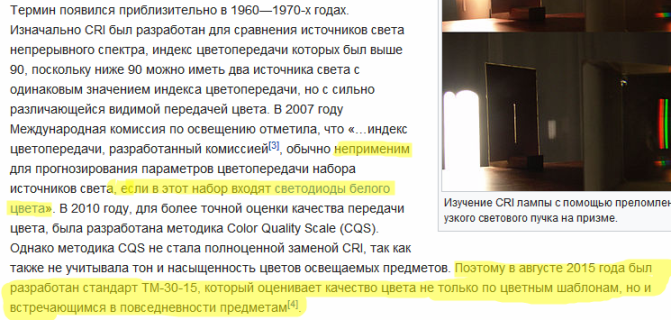
And here is an example of measuring the index of such a low-quality lamp:
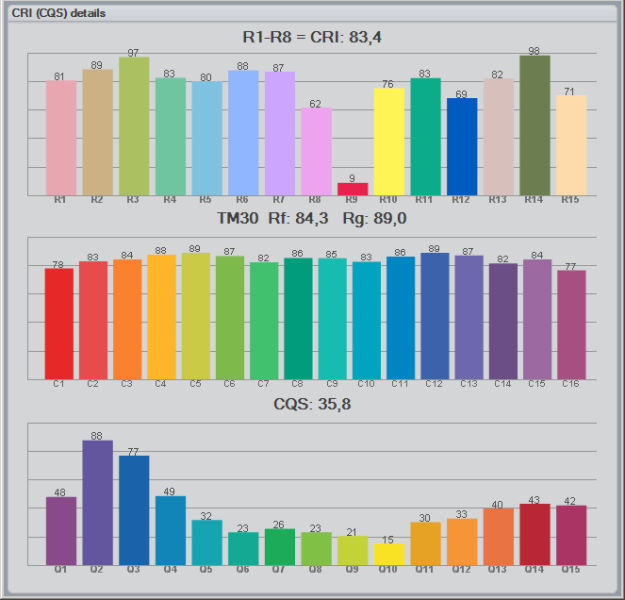
CRi corresponds to the declared one, all three measurements should be approximately the same, but look at CQS - it is very small 35.8, but it shone like this:

Even if you take into account that the camera distorts colors, it is still noticeable that the light has a pronounced green hue.
Since each room has its own normalized ripple coefficient and an acceptable color rendering index, it is not necessary to chase the ideal lighting in each room. For example, in the utility rooms, corridors and pantries, and in the bathrooms, a lot of serious visual work is not done, and you are there much less time than in the living room, kitchen, bedroom or office. Therefore, the requirements for lighting corridors are much milder than the requirements for the workshop and cabinet, in all respects.
This is stated in the headline that the cheapest lamp and lamp are perfect in the corridor, and vice versa in the office - give preference to high-quality and expensive light sources.
LED lamp power supply design
Since the light quality of LED lamps directly depends on the power historian, we will consider typical designs, in fact there are three of them.
Ballast capacitor
The circuit of transformerless power supplies and capacitor chargers is very old. Her work is based on limiting the current due to the reactance of the capacitance in alternating current. It is often used now for powering cheap radios, charging flashlights, powering LED lamps and lamps, and more. Its popularity is due to a minimum of parts and cost. The scheme you see below. Here C1 is a ballast capacitor, C2 is a smoothing or filtering one.

Output ripples depend on the ratio of the load to the capacity of the filtering electrolytic capacitor.
Previously, it was found in most of not even the cheapest LED lamps and fixtures. Now it is less common, mainly in the lower price segment. Lamps with such a power supply circuit may not pulsate at all if the filter capacitor is selected to a normal capacity, but more often craftsmen independently modify the lamps, increasing the filter capacity.
The second controversial link is ballast quenching capacitor. The smaller its capacity, the less current through the LEDs. Choosing the right capacity is hardly beneficial for the manufacturer, so often the current through the LEDs is too high, which makes the lamp glow brighter than the nominal, but not for long.
The third disadvantage of such lamps is that the current is not stabilized. This means that it also depends on the input voltage. If the lamp will work at high voltage, it will also fail faster.
The fourth problem - the reactance of the capacitor gives an indisputable advantage in that nothing is heated, but it is a consumer of reactive energy, it turns out that the lamp has a low cosine phi.Although at such capacities (up to a dozen watts) this is not so significant, but if there are 10 of these lamps in the apartment, and there are a couple of hundred of these apartments, then a good reactive load is already coming out.
Here is a disassembled photo of a similar lamp:
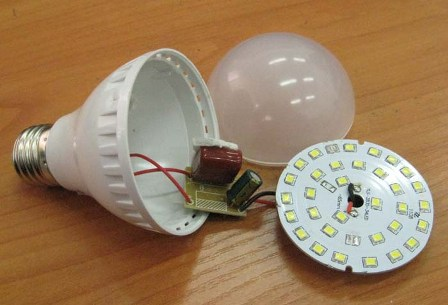
Their cost is usually up to 100 rubles per 10 W lamp, at the time of writing.
Pulse buck converter as driver
The lamp circuit, costing a little more than 100 - 200 rubles for a 10-13 W lamp, is shown below:
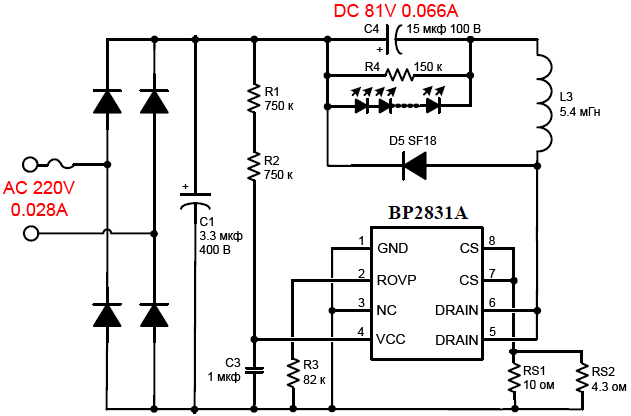
The advantages of such circuits are a microcircuit that controls the current in the load; a PWM controller with feedback is integrated in it. They are already more resistant to power surges, but even the driver itself or the LEDs can still fail from them. Such lamps rarely pulsate, and the color rendering index depends on the quality of the LEDs. Their low price is also an advantage.
The disadvantage is the lack of galvanic isolation. This means that the LEDs can have a rectified voltage of up to 310 V.
Here is a photograph of the insides of such a lamp.
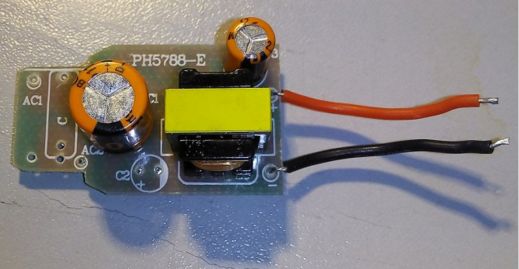
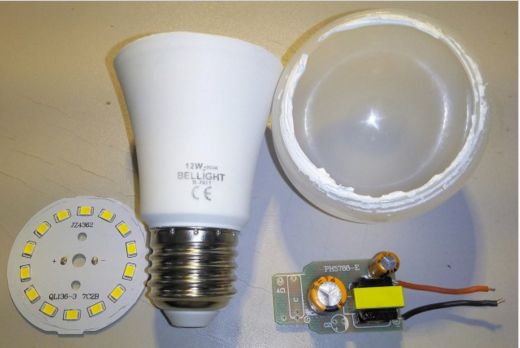
In expensive lamps, a transformer driver can be used. Its advantages are galvanic isolation and great reliability, but its cost will be more expensive than the previous one.
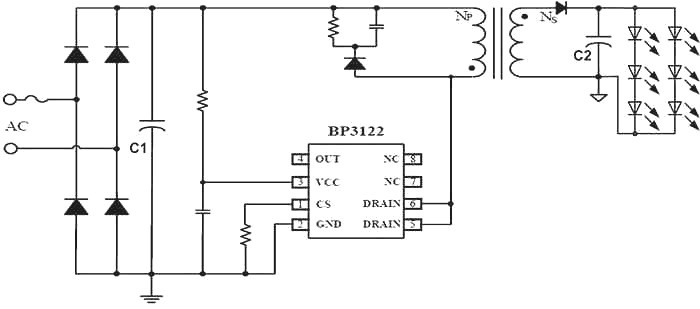
Conclusion
The main criterion for choosing an LED lamp is its cost, in most cases it allows you to determine the approximate composition of the lamp without disassembly. From a technical point of view, it is worth buying lamps in which there is at least some driver, and their pulsation can be superficially checked with the help of a mobile phone’s camera - in the video recording mode, bands will go through the frame. The color rendering index in the living conditions can not be verified, but still give preference to those lamps and lamps, the light of which is more pleasant for the eyes.
See also at bgv.electricianexp.com
:
